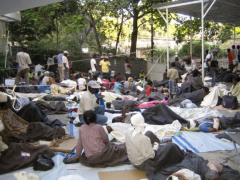Local Discovery Helps Earthquake Victims
Hope for Haiti thanks to Hammersmith Hospital research
The results of research carried out at Hammersmith Hospital 70 years ago are being used to help the people of Haiti following a devastating earthquake there last week.
Medical aid organisations who have rushed to the scene say many of the survivors are suffering from 'Crush Syndrome', a condition that was discovered at Hammersmith Hospital during the Second World War.
During the aerial bombardment of London, doctors noticed that many people who were dug out of the rubble of their own homes, and were apparently unscathed, then went on to collapse and die.
Writing in the British Medical Journal in 1990, Professor Eric Bywaters, who discovered the condition, described how the sudden deaths had initially baffled doctors: “On 16 September (1940), we received several casualties at Hammersmith - the usual lacerations, burns, fractures and shell shock - and also two patients with no apparent external injury. They had been buried in the debris of their houses for a number of hours and, when dug out, seemed to the front-line casualty doctors to be unscathed and have a normal blood pressure. In the melee, they received little attention for an hour or so, when they suddenly collapsed without sign of either external or internal bleeding but with gross limb swelling and skin wheals.”
Doctors found out that if people were buried under rubble for an extended period of time, their muscle cells would start to die, releasing toxins into their circulation and leading to irreversible kidney failure. To treat them, the toxins in the blood had to be diluted and flushed out using a saline solution.
Following this discovery, earthquake rescue teams, such as those in Haiti, know how to deal with crush injuries and crush syndrome. The aid organisation, Medecins Sans Frontiers (MSF), say they are working around the clock to treat the vast numbers of patients with serious injuries following the January 12 quake: “MSF staff are working flat out to stabilise the condition of the many people who have suffered serious crush injuries and offer what first aid they can for people with more minor injuries. The main concern at the moment from the medical staff in those clinics is that the need for wound treatment and major surgery is overwhelming,” the organisation says.
MSF say they have set up clinics in tents and treated over 1000 casualties since the earthquake struck. They say their medical teams have been performing Caesarian sections and amputations and that, due to the dire conditions, one team had to carry out 20 surgeries in a converted shipping container.
"The situation is chaotic. I visited five medical centres, including a major hospital and most of them were not functioning. I saw a distressing number of dead bodies. People have gathered outside, lighting fires in the street and trying to help and comfort each other. When they saw that I was from MSF they were asking for help, particularly to treat their wounded," said Stefano Zannini, the MSF head of mission.
The discovery at Hammersmith Hospital has been used to treat earthquake casualties around the world, from Iran to Indonesia and from China to Italy.
Yasmine Estaphanos
January 17, 2010
Related links
|
